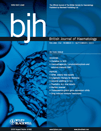Molecular analysis of globin gene expression in different thalassaemia disorders: individual variation of βE pre-mRNA splicing determine disease severity
Summary
Thalassaemia is characterized by the reduced or absent production of globins in the haemoglobin molecule leading to imbalanced α-globin/non α-globin chains. HbE, the result of a G to A mutation in codon 26 of the HBB (β-globin) gene, activates a cryptic 5′ splice site in codon 25 leading to a reduction of correctly spliced βE-globin (HBB:c.79G>A) mRNA and consequently β+-thalassaemia. A wide range of clinical severities in bothα- and β-thalassaemia syndromes, from nearly asymptomatic to transfusion-dependent, has been observed. The correlation between clinical heterogeneity in various genotypes of thalassaemia and the levels of globin gene expression and βE-globin pre-mRNA splicing were examined using multiplex quantitative real-time reverse transcription polymerase chain reaction (RT-qPCR) and allele-specific RT-qPCR. The α-globin/non α-globin mRNA ratio was demonstrated to be a good indicator for disease severity among different thalassaemia disorders. However, the α-globin/non α-globin mRNA ratio ranged widely in β-thalassaemia/HbE patients, with no significant difference between mild and severe phenotypes. Interestingly, the correctly to aberrantly spliced βE-globin mRNA ratio in 30% of mild β-thalassaemia/HbE patients was higher than that of the severe patients. The splicing process of βE-globin pre-mRNA differs among β-thalassaemia/HbE patients and serves as one of the modifying factors for disease severity.




